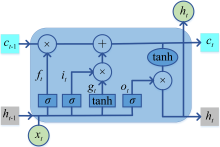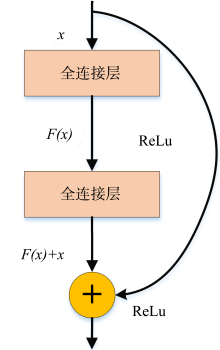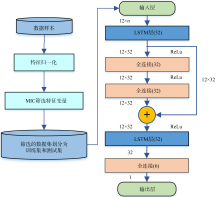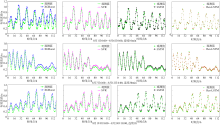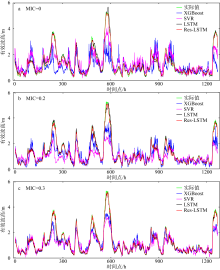| [1] |
周水华, 洪晓, 梁昌霞, 等, 2020. 基于人工神经网络的台风浪高快速计算方法[J]. 热带海洋学报, 39(4): 25-33.
doi: 10.11978/2019089
|
|
ZHOU SHUIHUA, HONG XIAO, LIANG CHANGXIA, et al, 2020. A method of tropical cyclone wave height calculation based on Artificial Neural Network[J]. Journal of Tropical Oceanography, 39(4): 25-33 (in Chinese with English abstract).
doi: 10.11978/2019089
|
| [2] |
朱道恒, 李志强, 2021. 最大互信息系数的并行计算方法研究[J]. 科学技术与工程, 21(34): 14625-14633.
|
|
ZHU DAOHENG, LI ZHIQIANG, 2021. Parallel calculation method for maximum information coefficient[J]. Science Technology and Engineering, 21(34): 14625-14633 (in Chinese with English abstract).
|
| [3] |
ABHIGNA P, JERRITTA S, SRINIVASAN R, et al, 2017. Analysis of feed forward and recurrent neural networks in predicting the significant wave height at the moored buoys in Bay of Bengal[C]// Proceedings of the 2017 international conference on communication and signal processing (ICCSP). Chennai: IEEE: 1856-1860.
|
| [4] |
BENGIO Y, SIMARD P, FRASCONI P, 1994. Learning long-term dependencies with gradient descent is difficult[J]. IEEE Transactions on Neural Networks, 5(2): 157-166.
doi: 10.1109/72.279181
pmid: 18267787
|
| [5] |
CORNEJO-BUENO L, NIETO-BORGE J C, GARCÍA-DÍAZ P, et al, 2016. Significant wave height and energy flux prediction for marine energy applications: a grouping genetic algorithm—extreme learning machine approach[J]. Renewable Energy, 97: 380-389.
|
| [6] |
DEKA P C, PRAHLADA R, 2012. Discrete wavelet neural network approach in significant wave height forecasting for multistep lead time[J]. Ocean Engineering, 43: 32-42.
|
| [7] |
FAN SHUNTAO, XIAO NIANHAO, DONG SHENG, 2020. A novel model to predict significant wave height based on long short-term memory network[J]. Ocean Engineering, 205: 107298.
|
| [8] |
FENG ZHIJIE, HU PO, LI SHUIQING, et al, 2022. Prediction of significant wave height in offshore China based on the machine learning method[J]. Journal of Marine Science and Engineering, 10(6): 836.
|
| [9] |
GAO SONG, ZHAO PENG, PAN BIN, et al, 2018. A nowcasting model for the prediction of typhoon tracks based on a long short term memory neural network[J]. Acta Oceanologica Sinica, 37(5): 8-12.
|
| [10] |
GAO SONG, HUANG JUAN, LI YARU, et al, 2021. A forecasting model for wave heights based on a long short-term memory neural network[J]. Acta Oceanologica Sinica, 40(1): 62-69.
|
| [11] |
GÜNER H A A, YÜKSEL Y, ÇEVIK E Ö, 2013. Estimation of wave parameters based on nearshore wind-wave correlations[J]. Ocean Engineering, 63: 52-62.
|
| [12] |
HASHIM R, ROY C, MOTAMEDI S, et al, 2016. Selection of climatic parameters affecting wave height prediction using an enhanced Takagi-Sugeno-based fuzzy methodology[J]. Renewable and Sustainable Energy Reviews, 60: 246-257.
|
| [13] |
HE KAIMING, ZHANG XIANGYU, REN SHAOQING, et al, 2016. Deep residual learning for image recognition[C]// IEEE conference on computer vision and pattern recognition. Las Vegas: IEEE: 770-778.
|
| [14] |
HOCHREITER S, SCHMIDHUBER J, 1997. Long short-term memory[J]. Neural Computation, 9(8): 1735-1780.
doi: 10.1162/neco.1997.9.8.1735
pmid: 9377276
|
| [15] |
LIU HUI, MI XIWEI, LI YANFEI, et al, 2019. Smart wind speed deep learning based multi-step forecasting model using singular spectrum analysis, convolutional Gated Recurrent Unit network and Support Vector Regression[J]. Renewable Energy, 143: 842-854.
|
| [16] |
MA KEZHAO, KONG JIA, WANG YIHAN, et al, 2022. Review of the applications of Kalman filtering in quantum systems[J]. Symmetry, 14(12): 2478.
|
| [17] |
MAHJOOBI J, ETEMAD-SHAHIDI A, KAZEMINEZHAD M H, 2008. Hindcasting of wave parameters using different soft computing methods[J]. Applied Ocean Research, 30(1): 28-36.
|
| [18] |
MAHJOOBI J, ADELI MOSABBEB E, 2009. Prediction of significant wave height using regressive support vector machines[J]. Ocean Engineering, 36(5): 339-347.
|
| [19] |
MAKARYNSKYY O, PIRES-SILVA A A, MAKARYNSKA D, et al, 2005. Artificial neural networks in wave predictions at the west coast of Portugal[J]. Computers & Geosciences, 31(4): 415-424.
|
| [20] |
ÖZGER M, 2010. Significant wave height forecasting using wavelet fuzzy logic approach[J]. Ocean Engineering, 37(16): 1443-1451.
|
| [21] |
RESHEF D N, RESHEF Y A, FINUCANE H K, et al, 2011. Detecting novel associations in large data sets[J]. Science, 334(6062): 1518-1524.
doi: 10.1126/science.1205438
pmid: 22174245
|
| [22] |
RIZAL A M, NINGSIH N S, 2020. Ocean wave energy potential along the west coast of the Sumatra island, Indonesia[J]. Journal of Ocean Engineering and Marine Energy, 6(2): 137-154.
|
| [23] |
RODRIGUEZ A, SÁNCHEZ-ARCILLA A, REDONDO J M, et al, 1995. Pollutant dispersion in the nearshore region: modelling and measurements[J]. Water Science and Technology, 32(9-10): 169-178.
|
| [24] |
SHAMSHIRBAND S, MOSAVI A, RABCZUK T, et al, 2020. Prediction of significant wave height; comparison between nested grid numerical model, and machine learning models of artificial neural networks, extreme learning and support vector machines[J]. Engineering Applications of Computational Fluid Mechanics, 14(1): 805-817.
|
| [25] |
|
| [26] |
THEODOROPOULOS P, SPANDONIDIS C C, THEMELIS N, et al, 2021. Evaluation of different deep-learning models for the prediction of a ship’s propulsion power[J]. Journal of Marine Science and Engineering, 9(2): 116.
|
| [27] |
WANG JICHAO, WANG YUE, YANG JUNGANG, 2021. Forecasting of significant wave height based on gated recurrent unit network in the Taiwan strait and its adjacent waters[J]. Water, 13(1): 86.
|
| [28] |
YANG SHAOBO, ZHANG ZHENQUAN, FAN LINLIN, et al, 2019. Long-term prediction of significant wave height based on SARIMA model in the South China Sea and adjacent waters[J]. IEEE Access, 7: 88082-88092.
|
| [29] |
YANG SHILUN, SHI BENWEI, BOUMA T J, et al, 2012. Wave attenuation at a salt marsh margin: a case study of an exposed coast on the Yangtze Estuary[J]. Estuaries and Coasts, 35(1): 169-182.
|
| [30] |
ZHANG DA, KABUKA M R, 2018. Combining weather condition data to predict traffic flow: a GRU-based deep learning approach[J]. IET Intelligent Transport Systems, 12(7): 578-585.
|
 ), LI Yan2, LI Zhiqiang1(
), LI Yan2, LI Zhiqiang1( ), LIU Run3
), LIU Run3


